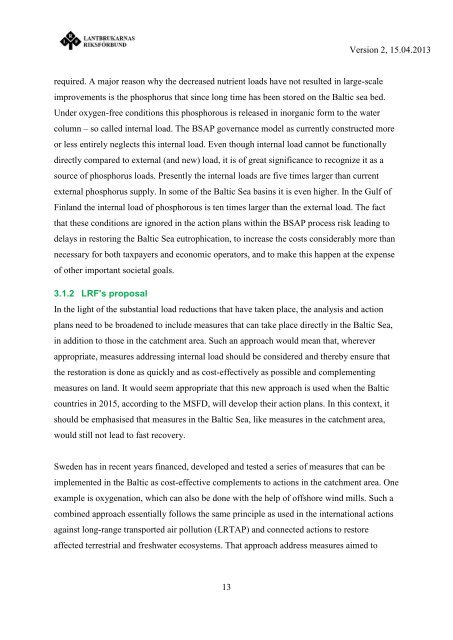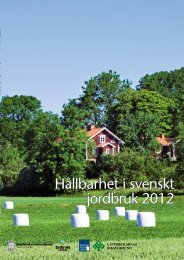LRFrapport_2013015
LRFrapport_2013015
LRFrapport_2013015
Create successful ePaper yourself
Turn your PDF publications into a flip-book with our unique Google optimized e-Paper software.
equired. A major reason why the decreased nutrient loads have not resulted in large-scale<br />
improvements is the phosphorus that since long time has been stored on the Baltic sea bed.<br />
Under oxygen-free conditions this phosphorous is released in inorganic form to the water<br />
13<br />
Version 2, 15.04.2013<br />
column – so called internal load. The BSAP governance model as currently constructed more<br />
or less entirely neglects this internal load. Even though internal load cannot be functionally<br />
directly compared to external (and new) load, it is of great significance to recognize it as a<br />
source of phosphorus loads. Presently the internal loads are five times larger than current<br />
external phosphorus supply. In some of the Baltic Sea basins it is even higher. In the Gulf of<br />
Finland the internal load of phosphorous is ten times larger than the external load. The fact<br />
that these conditions are ignored in the action plans within the BSAP process risk leading to<br />
delays in restoring the Baltic Sea eutrophication, to increase the costs considerably more than<br />
necessary for both taxpayers and economic operators, and to make this happen at the expense<br />
of other important societal goals.<br />
3.1.2 LRF's proposal<br />
In the light of the substantial load reductions that have taken place, the analysis and action<br />
plans need to be broadened to include measures that can take place directly in the Baltic Sea,<br />
in addition to those in the catchment area. Such an approach would mean that, wherever<br />
appropriate, measures addressing internal load should be considered and thereby ensure that<br />
the restoration is done as quickly and as cost-effectively as possible and complementing<br />
measures on land. It would seem appropriate that this new approach is used when the Baltic<br />
countries in 2015, according to the MSFD, will develop their action plans. In this context, it<br />
should be emphasised that measures in the Baltic Sea, like measures in the catchment area,<br />
would still not lead to fast recovery.<br />
Sweden has in recent years financed, developed and tested a series of measures that can be<br />
implemented in the Baltic as cost-effective complements to actions in the catchment area. One<br />
example is oxygenation, which can also be done with the help of offshore wind mills. Such a<br />
combined approach essentially follows the same principle as used in the international actions<br />
against long-range transported air pollution (LRTAP) and connected actions to restore<br />
affected terrestrial and freshwater ecosystems. That approach address measures aimed to




